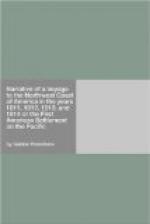[Footnote M: These caches are famous in all the narratives of overland travel, whether for trade or discovery. The manner of making them is described by Captains Lewis and Clarke, as follows: they choose a dry situation, then describing a circle of some twenty inches diameter, remove the sod as gently and carefully as possible. The hole is then sunk a foot deep or more, perpendicularly; it is then worked gradually wider as it descends, till it becomes six or seven feet deep, and shaped like a kettle, or the lower part of a large still. As the earth is dug out, it is handed up in a vessel, and carefully laid upon a skin or cloth, in which it is carried away, and usually thrown into the river, if there be one, or concealed so as to leave no trace of it. A floor of three or four inches thick is then made of dry sticks, on which is thrown hay or a hide perfectly dry. The goods, after being well aired and dried, are laid down, and preserved from contact with the wall by a layer of other dried sticks, till all is stowed away. When the hole is nearly full, a hide is laid on top, and the earth is thrown upon this, and beaten down, until, with the addition of the sod first removed, the whole is on a level with the ground, and there remains not the slightest appearance of an excavation. The first shower effaces every sign of what has been done, and such a cache is safe for years.—ED.]
CHAPTER XII
Arrival of the Ship Beaver.—Unexpected Return of Messrs. D. Stuart, R. Stuart, M’Lelland, &c.—Cause of that Return.—Ship discharging.—New Expeditions.—Hostile Attitude of the Natives.—Departure of the Beaver.—Journeys of the Author.—His Occupations at the Establishment.
From the departure of the last outfit under Mr. M’Kenzie, nothing remarkable took place at Astoria, till the 9th of May. On that day we descried, to our great surprise and great joy, a sail in the offing, opposite the mouth of the river. Forthwith Mr. M’Dougal was despatched in a boat to the cape, to make the signals. On the morning of the 10th, the weather being fine and the sea smooth, the boat pushed out and arrived safely alongside. Soon after, the wind springing up, the vessel made sail and entered the river, where she dropped anchor, in Baker’s Bay, at about 2 P.M. Toward evening the boat returned to the Fort, with the following passengers: Messrs. John Clarke of Canada (a wintering partner), Alfred Seton, George Ehnainger, a nephew of Mr. Astor (clerks), and two men. We learned from these gentlemen that the vessel was the Beaver, Captain Cornelius Sowles, and was consigned to us; that she left New York on the 10th of October, and had touched, in the passage, at Massa Fuero and the Sandwich Isles. Mr. Clarke handed me letters from my father and from several of my friends: I thus learned that death had deprived me of a beloved sister.




